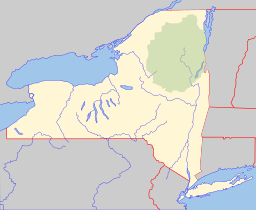| Great Sacandaga Lake | |
|---|---|
 A view of the Great Sacandaga Lake from a nearby overlook | |
| Location | Adirondack Park, Fulton / Saratoga / Hamilton counties, New York, U.S. |
| Coordinates | 43°08′30″N 74°10′39″W / 43.1417068°N 74.1776256°W, 43°16′33″N 74°02′31″W / 43.2757119°N 74.0420061°W[1] |
| Type | Reservoir, man-made construction: earth and concrete date: March 1930 |
| Primary inflows | Sacandaga River |
| Primary outflows | Sacandaga River |
| Catchment area | 1,044 sq mi (2,700 km2) |
| Basin countries | United States |
| Max. length | 29 mi (47 km) |
| Max. width | 5 mi (8.0 km) at its widest point |
| Surface area | 20,650 acres (32.27 sq mi)[1] |
| Average depth | 32 feet (9.8 m) |
| Max. depth | 70 feet (21 m) |
| Water volume | 29.920 billion cubic feet (847.2 hm3) low: 7.800 billion cubic feet (220.9 hm3) |
| Shore length1 | 66 miles (106 km) |
| Surface elevation | 771.0 ft (235.0 m) low: 740.0 ft (225.6 m)[2] |
| 1 Shore length is not a well-defined measure. | |
The Great Sacandaga Lake (formerly the Sacandaga Reservoir) is a large lake situated in the Adirondack Park in northern New York in the United States. The lake has a surface area of about 41.7 square miles (108 km2) at capacity, and the length is about 29 miles (47 km). The word Sacandaga means "Land of the Waving Grass" in the native Mohawk language. The lake is located in the northern parts of Fulton County and Saratoga County near the southern border of the Adirondack Park. A small portion also extends northward into southern Hamilton County. The broader, south end of the lake is northeast of the City of Johnstown and the City of Gloversville. Great Sacandaga Lake is a reservoir created by damming the Sacandaga River. The primary purpose for the creation of the reservoir was to control flooding on the Hudson River and the Sacandaga River, floods which had a historically significant impact on the surrounding communities.

